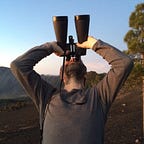DIY Studio Strobe Part 3: Remote Trigger for Vintage Flashes
How you can trigger your DIY studio strobe wirelessly and reliably without damaging your camera.
I love black and white film photography and I love using old equipment and old techniques in my photography where I can. I also love recycling old equipment and modifying it to give it a new lease of life.
In this three article series, I show how a vintage Vivitar 283 speedlight can be upcycled to create an affordable and versatile Bowens-compatible studio strobe.
In this final article, I explain how you can trigger your DIY studio strobe wirelessly and reliably without damaging your camera. In the previous two articles, I explained how to add a modelling light, a Bowens-compatible adapter and how to create a manual power controller to the ever popular Vivitar 283 flash.
The most common vintage photo accessories are lenses and on-camera flashes (speedlights).
Vintage lenses are largely problem free: you need to be careful to check they work correctly and that the optics aren’t affected by fungus or excessive dustbut beyond that, with the right adapter, you can fit most lenses from the 70s, 80s and 90s to a modern camera (D)SLR or mirrorless camera without much trouble or risk.
Vintage on-camera flashes with modern cameras is an entirely different story.
Never, never connect vintage flash accessories directly to a modern camera unless you know precisely what you are doing. As a rough guide, you should consider any flash accessory produced before 1995 as vintage.
The trigger voltages for some flash accessories made in the 1970s or earlier can be as high as 200–300V DC. To put that in perspective, a trigger voltage of 6V DC will burnout the electronics in modern cameras.
Most of the vintage flash accessories you’ll find on eBay, etc will likely have a trigger voltage in the 20–30V DC range. Which is still more than high enough to burnout a digital camera.
You can buy various “safe” hot shoe adapters and inline sync cords but they are relatively expensive and have the downside that they maintain a physical connection between your camera and the flash. The alternative is to use a wireless flash trigger, so that there is no physical connection between the flash and your camera. Burning out an easily replaced €30 wireless receiver is preferable to doing the same to a camera.
Wireless Receivers
Neewer PT-16GY 16 Channels Wireless Remote Flash Speedlite Trigger
If you are going to be using your DIY Studio Strobe with a vintage camera with a flash sync speed of 1/60th second or less then the Neewer/Andoer PT-16GY is a good choice. There is a PC-sync socket built into the side of the receiver plus a hot shoe. The receiver fits on the the Vivitar 283’s cold shoe and connects via the PC-sync socket.
The Neewer PT-16GY is an older product and is no longer listed on Neewer’s website. The same product is still listed on Andoer’s website. It can be purchased on eBay in the US for around $20 and imported direct from China for around €15 plus taxes.
It’s easy to confuse the PT-16GY with the similarly named Neewer FC-16, which also has a hot shoe connection but lacks the PC-sync socket.
The main drawbacks that I’ve found with the PT16-GY are build quality and issues problems syncing above 1/60th on film cameras.
I’ve tried a total of 4 PT-16GY receivers (2 Neewer branded and 2 Andoer branded):
- One of the Neewer branded receivers regularly failed to trigger leading to lots of wasted frames of film; and
- All 4 of the receivers failed to trigger when used at 1/125th second on my Nikon F80D SLR.
Bresser T-13 Universal Wireless Trigger Set
If you are going to be using your DIY Studio Strobe with a vintage camera with a flash sync speed of 1/125th second or above then I recommend using the Bresser T-13. The Neewer RT-16 and the similar Godox RT-16 are likely to be just as good but I haven’t tested them.
The receivers in these products are designed to work with studio strobes and do not include a PC-sync connection or a hot shoe. Instead, they feature a cable with a 3.5mm plug, the de facto standard for more modern studio lighting accessories. So you need a 3.5mm to PC-sync adapter in order to connect it to the Vivitar 283.
Sync Cables
In the pictures above, I’m using:
- a 3.5mm socket to 3.5mm socket adapter — around €4
- a 3.5mm plug to PC-Sync socket adapter cable — around €5
The Vivitar 283 uses a proprietary sync cable with a PC-sync plug at one end and a proprietary plug at the other. For this reason, you need a cable with a 3.5mm socket (female) at one end and a PC-sync socket (female) at the other end.
A 3.5mm socket (female) to PC-sync socket (female) adapter cable was never a popular choice because studio strobes have and had a 3.5mm socket. So, it’s easier to find a 3.5mm plug (male) to PC-sync socket (female) adapter cable and join them using a 3.5mm socket to 3.5mm socket adapter.
I a PC Female to 3.5mm Male FLASH Sync Cable Cord for Studio Flash bought via eBay.
Finally
The image below utilises low key split lighting using one of my DIY studio strobes. The DIY studio strobe was fitted a standard 7" reflector and a diffuser “sock” and triggered using a Bresser T-13 universal wireless trigger.
